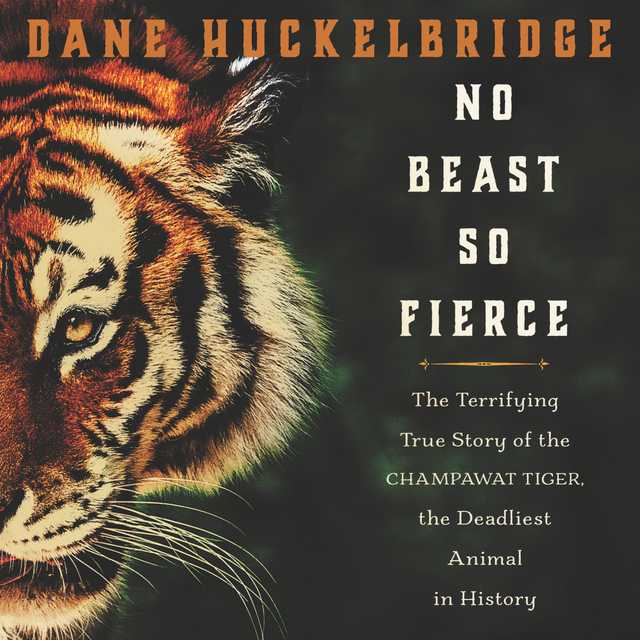No Beast So Fierce Audiobook Summary
A gripping, multifaceted true account of the deadliest animal of all time and the hunter on its trail, equally comparable to Jaws as to Matthiessen’s The Snow Leopard.
“RIVETING.” —Scientific American * “THRILLING.” —Wall Street Journal * “GRIPPING.” —Nature
Nepal, c. 1900: The single deadliest animal in recorded history began stalking humans, moving like a phantom through the lush foothills of the Himalayas.
As the death toll reached an astonishing 436 lives, a young local hunter was dispatched to stop the now-legendary man-eater before it struck again.
One part pulse-pounding thriller, one part soulful natural history of the endangered Royal Bengal tiger, acclaimed writer Dane Huckelbridge’s No Beast So Fierce is the gripping, true account of the Champawat Tiger, which terrified northern India and Nepal from 1900 to 1907, and Jim Corbett, the legendary hunter who pursued it. Huckelbridge’s masterful telling also reveals that the tiger, Corbett, and the forces that brought them together are far more complex and fascinating than a simple man-versus-beast tale.
At the turn of the twentieth century as British rule of India tightened and bounties were placed on tiger’s heads, a tigress was shot in the mouth by a poacher. Injured but alive, it turned from its usual hunting habits to easier prey–humans. For the next seven years, this man-made killer terrified locals, growing bolder with every kill. Colonial authorities, desperate for help, finally called upon Jim Corbett, a then-unknown railroad employee of humble origins who had grown up hunting game through the hills of Kumaon.
Like a detective on the trail of a serial killer, Corbett tracked the tiger’s movements in the dense, hilly woodlands–meanwhile the animal shadowed Corbett in return. Then, after a heartbreaking new kill of a young woman whom he was unable to protect, Corbett followed the gruesome blood trail deep into the forest where hunter and tiger would meet at last.
Drawing upon on-the-ground research in the Indian Himalayan region where he retraced Corbett’s footsteps, Huckelbridge brings to life one of the great adventure stories of the twentieth century. And yet Huckelbridge brings a deeper, more complex story into focus, placing the episode into its full context for the first time: that of colonialism’s disturbing impact on the ancient balance between man and tiger; and that of Corbett’s own evolution from a celebrated hunter to a principled conservationist who in time would earn fame for his devotion to saving the Bengal tiger and its habitat. Today the Corbett Tiger Reserve preserves 1,200 km of wilderness; within its borders is Jim Corbett National Park, India’s oldest and most prestigious national park and a vital haven for the very animals Corbett once hunted.
An unforgettable tale, magnificently told, No Beast So Fierce is an epic of beauty, terror, survival, and redemption for the ages.
Other Top Audiobooks
No Beast So Fierce Audiobook Narrator
Corey Snow is the narrator of No Beast So Fierce audiobook that was written by Dane Huckelbridge
Dane Huckelbridge has written for the Wall Street Journal, Tin House, The New Republic, and New Delta Review. He is the author of Bourbon: A History of the American Spirit; The United States of Beer: The True Tale of How Beer Conquered America, From B.C. to Budweiser and Beyond; and a novel, Castle of Water, which has been optioned for film. A graduate of Princeton University, he lives in Paris.
About the Author(s) of No Beast So Fierce
Dane Huckelbridge is the author of No Beast So Fierce
More From the Same
- Author : Dane Huckelbridge
- Castle of Water
- The United States of Beer
- Publisher : HarperAudio
- Abraham
- American Gods [TV Tie-In]
- Dead Ringer
- House of Sand and Fog
- Prey
No Beast So Fierce Full Details
| Narrator | Corey Snow |
| Length | 8 hours 8 minutes |
| Author | Dane Huckelbridge |
| Category | |
| Publisher | HarperAudio |
| Release date | February 05, 2019 |
| ISBN | 9780062898418 |
Subjects
The publisher of the No Beast So Fierce is HarperAudio. includes the following subjects: The BISAC Subject Code is Asia, History, India & South Asia
Additional info
The publisher of the No Beast So Fierce is HarperAudio. The imprint is HarperAudio. It is supplied by HarperAudio. The ISBN-13 is 9780062898418.
Global Availability
This book is only available in the United States.
Goodreads Reviews
Amy
February 04, 2019
“That when it comes to truly behaving as a beast — to killing wantonly and without reason — it is our kind, not theirs, that is the fiercer of the two.”I won this book through a giveaway in exchange for an honest review....Technically, I won a different book, but the publisher had some issue and wasn’t able to send out the books to the giveaway winners, but didn’t want to leave them empty handed, so instead sent this book. This was a wonderfully written nonfiction book about the Champawat Tiger! Honestly, I didn’t actually think I would finish it. I figured I would just kind of skim it....However, that was not the case! I actually really enjoyed it. Not to mention, I learned quite a bit too - which is always a great feeling after reading a book!
Philip
October 18, 2020
If all you want is to learn the story of the Champawat tiger, the undisputed deadliest single animal in history, you can get that from Wikipedia or websites such as https://curioushistorian.com/jim-corb.... However, if you really want to know the story, then this is the best book out there, short of perhaps reading Jim Corbett's books themselves.Like any good book that at first blush appears to focus on a single narrow topic - I'm thinking something like The Library Book here - it should approach that topic from every conceivable angle, and as a result suck you into a whole number of peripheral stories. In this case, we not only get the intimate story of the Champawat and her ultimate dispatch at the hands of a then still-green Jim Corbett, but also history lessons on the Nepalese dynasties and colonial India; an overview of all man-eating animals; tutorials on the biology, geology, ecology and sociology of the Himalayan foothills; a neat biography of Corbett as a product of the Irish diaspora; and several other fascinating topics.In this modern world of national borders and human-on-human disputes, it's important to remember that nature doesn't respect lines on a map; and that up until the late 19th century South/Southeast Asia was largely one contiguous forest that spread from northern Pakistan and India down through Burma/Thailand and the Malay Peninsula before leaping the Straits and continuing into Indonesia, (see the famous story of Singapore's last tiger being shot in the Raffles Hotel). And that's why (other than Siberia's enormous Amur tigers), panther tigris roamed largely unimpeded for centuries across the entire region in such oh-so-subtly speciated iterations as the Malayan, Indochina, South China and Sumatran tigers. However, with today's over-exploitation of Asia's forests and over-hunting of all its remaining megafauna, not only has this endless forest been largely reduced to a series of few-and-far-between nature preserves, ALL of the above species are now critically endangered, (while at least two others - the Bali and Javan tigers - are already extinct). I remember when we lived in Kuala Lumpur in the late 90's, we would regularly read heartbreaking stories about tigers "having to be" caught and/or killed in places where their former jungle home had been cut down and converted into the neat (and endless) rows of oil palm plantations, the sad result of unceasing human encroachment into their historical hunting grounds, all in pursuit of ever-cheaper shampoo ingredients...(PHOTO: top half is original rain forest; bottom is oil palm)Don't get me wrong: one doesn't root for the tiger in this story - his killing and devouring of nearly half a thousand people is just too horrendous, especially as described by Hucklebridge. But one does feel enormous sympathy for this magnificent creature, who turned to man-hunting only because his initial wounding at human hands left him incapable of catching anything but this slower and dumber bipedal prey. This is a fascinating story artfully told,* and a solid recommend for any student of nature, animals or the price we continue to pay for our ongoing desecration of the natural world.* SAMPLE: "...the Champawat's human victim never even knew what hit her. Perhaps the faintest rustling when it launched from the ground, a soft puff of displaced air from its careening body, all registered in the back of the mind at nearly the same moment nature's nearest equivalent to a short-range missile exploded upon its target."BONUS FEATURES: (1) Totally coincidental, the below photo just won National Geographic's 2020 Wildlife Photo of the Year:(2) While no film version of this story has yet been made (but definitely should), any interested reader might enjoy 1996's "The Ghost and the Darkness," which tells the similar - and, amazingly, contemporary - story of the hunt for the "Tsavo Man-Eaters," a pair of lions which were responsible for killing a number of construction workers on the Kenya-Uganda Railway in 1898. While a thin Val Kilmer and young(ish) Michael Douglas are no longer to be found, the reconstructed lions can still be seen in Chicago's Field Museum of Natural History, coronavirus permitting. (3) And finally, this fun fact that continues to blow my mind: the words "general" and "specific" come from the taxonomical terms "genus" (e.g., "homo") and species (e.g., "sapiens"). So obvious in hindsight, but I never realized that until it was pointed out to me recently, and now it's my go-to fact to either impress the hell out of someone (one type of person), or totally kill a conversation (the other type).
Joe
October 16, 2018
The true story of a Bengal tiger that killed over 400 people in Nepal and India a little over 100 years ago. I had no idea of how efficient a killing machine tigers are and how many people they have killed over the years. One instant you are standing at the edge of the woods and the next the tiger is already sprinting away with another victim in its mouth. Chilling. All set within the backdrop of the Indian subcontinent and the changes over the years leading to more human deaths. Nonfiction fans will eat this one up. Sorry for the bad pun...
Books on Stereo
April 02, 2019
Non-fiction at its finest.
Edward
May 17, 2021
A gripping, suspenseful story but I especially appreciated how Huckelbridge weaved the cultural, environmental, and historical dimensions into the narrative.
Navi
December 27, 2019
I enjoyed this book a lot more than I thought I would. The author did a great job writing a compelling and emotionally charged account of the Champawat Tiger. I was surprised that I had not heard about this tiger before reading this book. The Champawat notoriously killed more than 400 people in India and Nepal. There are two narratives running through this book. The author provides a (sometimes imagined) account of the Champawat and also provides interesting facts about Bengal tigers. The second narrative thread focuses on Jim Corbin, a railroad worker known for his excellent shot. We learn about the life of Corbin and what led him to kill the Champawat. I would have given this book 5 stars but there are sections of the book that lack cohesion. However, this was still a fantastic read filled with horror and adventure!
Rick
February 21, 2019
Recently finished reading this book about a tiger in Nepal at the dawn of the twentieth century that stalked, killed, and ate 436 people, averaging a person a week for ten years. I was initially wary of reading this because I love the John Vaillant book so much but this won me over with its insistence on looking at the influence of the loss of habitat, prey, and colonialism on the tiger's behavior. One of the fascinating things I noticed was how colonialism resembles a more brutal version of gentrification, replacing physical violence with economic violence. I think this book makes a compelling argument for humans being the most savage species, as Shakespeare said so well:“No beast so fierce but knows some touch of pity. But I know none, and therefore am no beast.”― William Shakespeare, Richard III
Cheryl
February 03, 2019
I only know a slight bit of information about the Champawat Tiger. Therefore, I found this book to be very interesting to learn about animals from other countries. To be honest, when I think of "deadly" animals; the Champawat Tiger is not one that makes the top ten list. However, after reading this book it is right up in the top animals of the world. This is no joke as the Champawat Tiger held four hundred and thirty six kills before Jim Corbett killed him. Although, reading this book, I can imagine in those moments when Jim killed the Champawat Tiger that it was with some remorse and respect for the beast. Mr. Huckelbridge writes as a good storyteller. He provided plenty of details without allowing the book to be bogged down with details. Also, it felt as if I was transported back in time and stepped into Jim's shoes as he hunted the Champawat Tiger. Anyone who likes to read nonfiction books, should pick up a copy of this book.
Ryan
February 14, 2019
When excellent writing is combined with a favorite subject matter it results in a near perfect score. I say 'near' because I overlooked the few minor faults that did not detract from my enjoyment of this book. Huckelbridge gives a detailed account of not just the actual hunting of the tiger and it's exploits, but a comprehensive overview of the history of the region, from the terai grasslands to the Himalayan foothills that comprise the lands bordering western Nepal and northern India. The military, political and environmental backdrop is told in an engaging way, never going into too much detail to bore the lay person, but all important in helping to understand the context in which rampant man-eating by tigers and leopards arose. Yes, one can simply read Jim Corbett's books for the thrills and adventure direct from the horse's mouth, but I learnt a great deal more from this work, of how the British started the process of emphasizing economic production of export crops and timber over the sustainable lifestyles of the country's original inhabitants, in so doing converting swathes of forests into farms and imposing a system of wage labor over subsistence living. How after the Mutiny of 1857 access to weapons of all sorts, not just firearms, were severely curtailed, resulting in villagers becoming totally defenseless against the ravages of wild animals. Of course most man-eaters were driven to the practice due to injuries, again primarily caused by inexperienced 'sport' shooters whose numbers increased with British rule, but these broader negative factors were also at play in aggravating the situation. There is a bibliography section with some helpful references, but the book could have had more detailed notes to guide those who wish to pursue further independent research. The word 'colonist' was also used repeatedly when I suppose the author meant 'colonialist', since the British never really set up colonies of immigrants as they did in Australia or North America, but imposed colonial rule over the locals. However as mentioned these are but minor faults and the book remains a very fascinating study of a specific place and time. Oh and there was also the obligatory coverage of tiger biology and ecology, albeit sometimes in an overly sensationalist style..
Kim
May 07, 2019
I may be in the minority, but I am on the side of the tiger in this heartbreaking, yet fascinating, book. The Champawat Tigress killed and ate more than 450 people in Nepal and India in the early 1900s; here, we learn how injury, colonization and habitat loss likely led to the creation of this fearsome man-eater. No Beast So Fierce is an amazing cautionary tale on how we bring about deadly consequences with our foolhardy insistence on 'civilizing' colonized lands by clearing the wild jungle and forest habitats needed by apex predators, who require vast territories to survive.This was a gripping and informative read that had me enthralled. It detailed the expansion of the British empire into India and how that impacted the delicate balance of human habitation coexisting with the natural world. It is sad how human progress exacts a high price on the creatures that share the planet with us. We also learn quite a lot of the background behind Jim Corbett, the man who ultimately brings down the tigress. As an Irishman who grew up in India, his life was unusual and provided him with the exceptional skill needed to face down the Champawat tigress. She was the first, but not the only man-eater he killed before his life took him to works of conservation and safeguarding these beautiful, majestic creatures. An awe-inspiring tale. I don't read a lot of nonfiction but this book was captivating in such a way as to make me yearn for more books like this.
Darcee
December 28, 2018
I won this book in the first reads giveaway. I was enthralled and shocked by this terrifying, but true tale of the Champawat Tiger. Well written and entertaining, I thoroughly enjoyed this story.
Justin
May 22, 2020
A lot of thoughts with this one! First, I am always a little more fascinated by nonfic that takes historic one-off stories and connects them to larger issues/events of historic significance. This one takes an interesting tale of a murderous tiger (at least 436 human kills attributed to this one tigress!) and uses this tale to not only tell a thrilling story of the hunt and kill of the animal, but to tell a larger story about Nepal and India. I know just the basic, history class minimum of the East India Trading Company, British colonialism, etc. Here, Huckelbridge makes connections between the encroaching rules and exploitation of British conquest and the increasing clash man and nature. There is an interesting subtext of who is the actual beast, what is the nature of nobility, etc. Second, I really liked Huckelbridge's writing style. He has an amazing vocabulary. It does not make the text dense at all or come off as pretentious. It's actually refreshing and makes you think you're reading something of heft and significance. My only gripes are that more spotlight could have been given to Corbett's hunt and future hunts. They are the most exciting part of this tale. More eyewitness accounts would have added to the terror, too...though I understand the author has little control of their availability. Also, this book has sections that feel repetitive. I've noticed that in a few recent nonfic pieces and I wonder if it's a case of editing needing to be tightened up or an author trying to keep certain facts in the readers' minds...but I find it annoying. I would read more from Huckelbridge, though!
Doug
May 07, 2021
I’m reading this on the heels of The Hunter’s Way by Raleigh and The Tiger by Vaillant because I can’t seem to get enough of a topic once I start. It’s not bad, about the Irish hunter extraordinaire, Jim Corbett, asked to save a territory in India where over 400 people have been killed by a rogue tiger. Yeah, over 400. It’s a big number and a horrifying story. The author tells it well, straight-up. If you like you true-life adventures told without any digressions or straying off course, this is a terrific read.However, coming on the heels of The Tiger by Vaillant which I read the week before, about a tiger in Russia who kills a mere four people, it’s surprisingly less epic and less powerful. The tone of No Beast is a tad more light, the prose more gentle. The Tiger, with its heightened intensity, also digresses a great deal – communism, perestroika, the psychological effects of isolation – no topic is off-topic. To some, it slows the pace down. To others (like me) it brilliantly incorporates history, psychology, philosophy and suspense into a breath-taking whole.It's a matter of taste. To digress or not to digress. I preferred the digressions, but No Beast So Fierce is still a perfectly good true-life nail-biter, if not exactly ground-breaking.
Audrey
February 09, 2022
The last sentence of this story really sums it all up: “That when it comes to truly behaving as a beast - to killing wantonly and without reason - it is our kind, not theirs, that is the fiercer of the two”. 🧡🐅I LOVED this book, and the author did a fantastic job highlighting how colonialism coupled with habitat destruction, over exploitation, and industrialism is what led to the creation of this “man-eater”, as tigers generally would never attack humans. The final chapters of the hunt were thrilling, and once it was over I found myself incredibly sad for the tiger, who was simply just trying to survive in an ever changing and advancing world that left it injured and unable to hunt properly. I loved learning about Jim Corbett and the incredible conservation work he completed for Bengal Tigers after the hunt.
Most Popular Audiobooks
Frequently asked questions
Listening to audiobooks not only easy, it is also very convenient. You can listen to audiobooks on almost every device. From your laptop to your smart phone or even a smart speaker like Apple HomePod or even Alexa. Here’s how you can get started listening to audiobooks.
- 1. Download your favorite audiobook app such as Speechify.
- 2. Sign up for an account.
- 3. Browse the library for the best audiobooks and select the first one for free
- 4. Download the audiobook file to your device
- 5. Open the Speechify audiobook app and select the audiobook you want to listen to.
- 6. Adjust the playback speed and other settings to your preference.
- 7. Press play and enjoy!
While you can listen to the bestsellers on almost any device, and preferences may vary, generally smart phones are offer the most convenience factor. You could be working out, grocery shopping, or even watching your dog in the dog park on a Saturday morning.
However, most audiobook apps work across multiple devices so you can pick up that riveting new Stephen King book you started at the dog park, back on your laptop when you get back home.
Speechify is one of the best apps for audiobooks. The pricing structure is the most competitive in the market and the app is easy to use. It features the best sellers and award winning authors. Listen to your favorite books or discover new ones and listen to real voice actors read to you. Getting started is easy, the first book is free.
Research showcasing the brain health benefits of reading on a regular basis is wide-ranging and undeniable. However, research comparing the benefits of reading vs listening is much more sparse. According to professor of psychology and author Dr. Kristen Willeumier, though, there is good reason to believe that the reading experience provided by audiobooks offers many of the same brain benefits as reading a physical book.
Audiobooks are recordings of books that are read aloud by a professional voice actor. The recordings are typically available for purchase and download in digital formats such as MP3, WMA, or AAC. They can also be streamed from online services like Speechify, Audible, AppleBooks, or Spotify.
You simply download the app onto your smart phone, create your account, and in Speechify, you can choose your first book, from our vast library of best-sellers and classics, to read for free.
Audiobooks, like real books can add up over time. Here’s where you can listen to audiobooks for free. Speechify let’s you read your first best seller for free. Apart from that, we have a vast selection of free audiobooks that you can enjoy. Get the same rich experience no matter if the book was free or not.
It depends. Yes, there are free audiobooks and paid audiobooks. Speechify offers a blend of both!
It varies. The easiest way depends on a few things. The app and service you use, which device, and platform. Speechify is the easiest way to listen to audiobooks. Downloading the app is quick. It is not a large app and does not eat up space on your iPhone or Android device.
Listening to audiobooks on your smart phone, with Speechify, is the easiest way to listen to audiobooks.






























